Imagine using the grandeur of plants with big leaves to turn your living area into a lush retreat. These enormous plants are declarations of natural refinement and elegance, rather than just lush vegetation.
Every leaf conveys a tale of tropical beauty and intrigue, from the delicate sway of palm fronds to the elaborate patterns of calatheas.
These gorgeous flora wonders will elevate your home’s decor and help you experience the peace of nature at its best.
Different Types of Plants with Big Leaves
Red Aglaonema
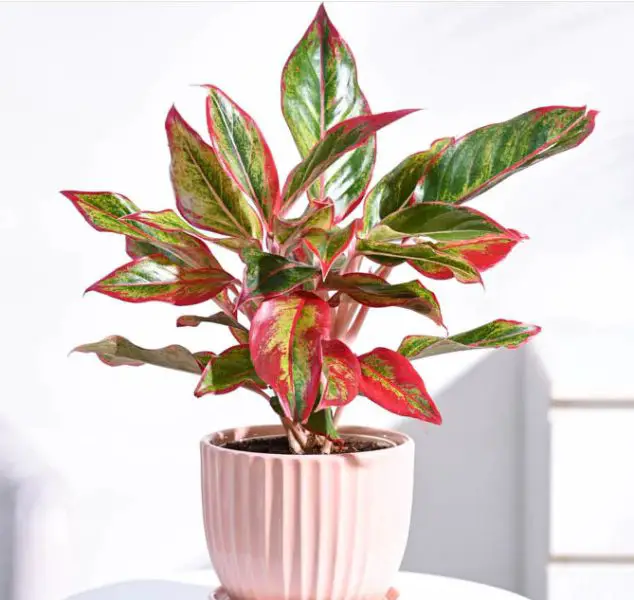
The Red Aglaonema is a tropical plant that has beautiful red foliage with green highlights. This exotic plant has heart-shaped and lance-shaped leaves. Varieties of this plant have green and variegated red or pink colors.
When grown indoors, this plant can reach heights of 2 to 3 feet, with leaves that are 4 to 12 inches in length and 2 to 4 inches in width. Famous red cultivars that bring vivid color to any interior area are Siam Red, Siam Aglaonema, Red Emerald, and Red Anjamani.
Philodendron Gloriosum

The Philodendron Gloriosum is a remarkable variety characterized by its large, velvety, deep green leaves adorned with white veining. Thriving in bright, indirect sunlight and well-draining soil, this plant is toxic to humans and pets.
Its rarity makes it a coveted find, often available only through online sources or from dedicated local collectors, adding to its allure and desirability among plant enthusiasts.
Heliconia Plants
![]()
Native to tropical rainforests, heliconia plants are known for their enormous, banana-shaped leaves, which grow to a height of six to ten feet on robust stalks. Their unique blooms, which resemble bird beaks similar to those of bird of paradise flowers, enhance their attraction. Some species have bright red or orange flowers, and they are found mostly in Florida and California.
Though they are usually grown outside, they may be cultivated indoors in large spaces. Often referred to as false birds of paradise, lobster-claws, wild plantains, and toucan beaks, they lend a touch of tropical elegance to any scene.
Banana Tree Plant (Musa)
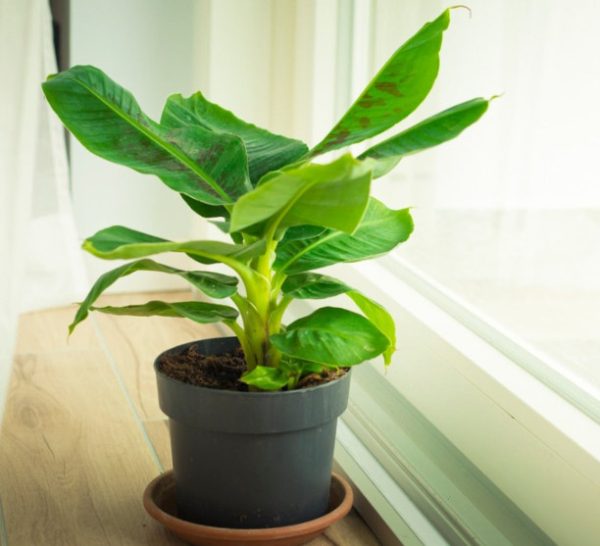
The remarkable, enormous tropical leaves of the Banana Tree Plant, or Musa, are what make it unique. Leaves on mature specimens can grow up to 2 feet broad and 9 feet long. Although it is usually grown outside, it may grow well indoors in areas that are bright and sunny and have soil that drains well, especially in the growing season.
Plant aficionados love it because of its luxuriant foliage, which gives any indoor environment a touch of tropical flare.
Peacock Plant (Calathea makoyana)
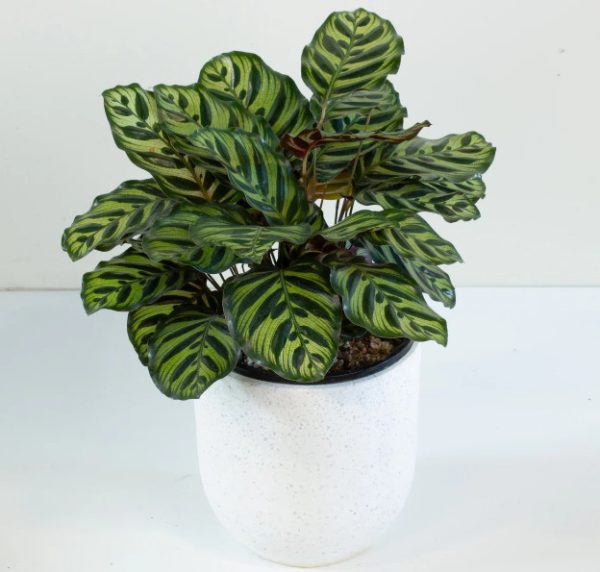
The Peacock Plant, scientifically known as Calathea makoyana, earns its name from its striking green patterned leaves reminiscent of a peacock’s tail. This big-leafed plant can reach heights of 3 to 5 feet and widths of 2 to 3 feet.
As a Calathea species, it flourishes indoors with proper care, including bright, indirect sunlight, moist, well-draining soil, and minimal fertilization. Its ornamental foliage adds a touch of exotic beauty to any indoor space.
Majesty Palm (Ravenna rivularis)
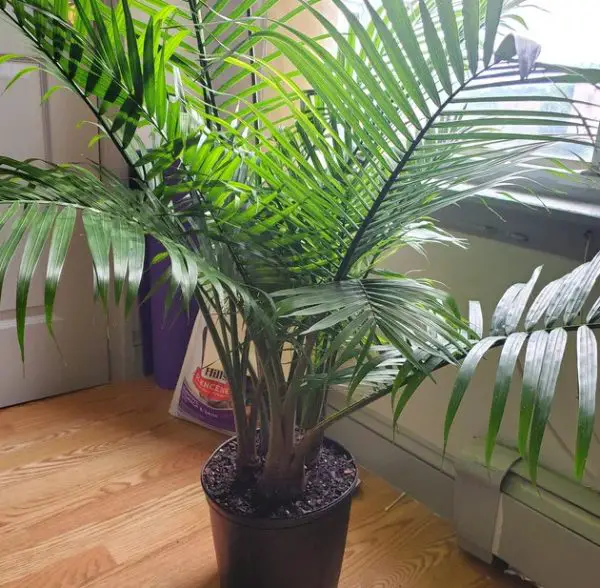
The Majesty Palm, scientifically known as Ravenna rivularis, is a stunning indoor palm tree renowned for its regal appearance. Despite its slow-growing nature, it can reach heights of about 10 feet, boasting large green fronds atop multiple stalks.
While challenging to maintain indoors, it’s a perfect choice for those lacking a green thumb. Providing optimal conditions, including bright, indirect light, well-draining soil, and consistent moisture without waterlogging, ensures this majestic plant thrives and flourishes.
Calathea orbifolia
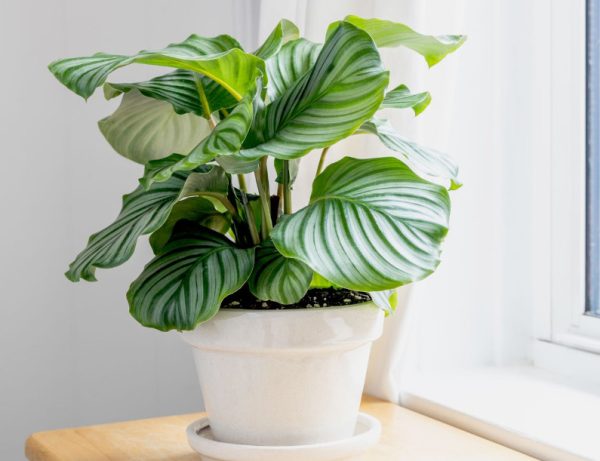
The huge orb-shaped leaves of the prayer plant variation Calathea Orbifolia make it stand out. This attractive plant needs rich, well-draining, continuously moist soil, and it thrives in bright, indirect light.
Some indoor gardeners find it challenging because of its preference for high humidity levels. Nonetheless, the Calathea Orbifolia may make a magnificent addition to any interior setting with the right maintenance and attention to its requirements for light, soil, and humidity.
Tropic Snow Dumb Cane (Dieffenbachia seguine)

Dieffenbachia seguine, the scientific name for the Tropic Snow Dumb Cane, is one of the bigger species of dumb cane plants and can grow up to ten feet tall indoors. It is relatively minimal care and gives a touch of tropical beauty to any place with its large, variegated foliage.
It’s not too picky—it thrives in low light and can tolerate neglect—but it does appreciate well-drained soil. It’s crucial to remember that it is poisonous to both people and animals.
Ruffled Fan Palm (Licuala grandis)
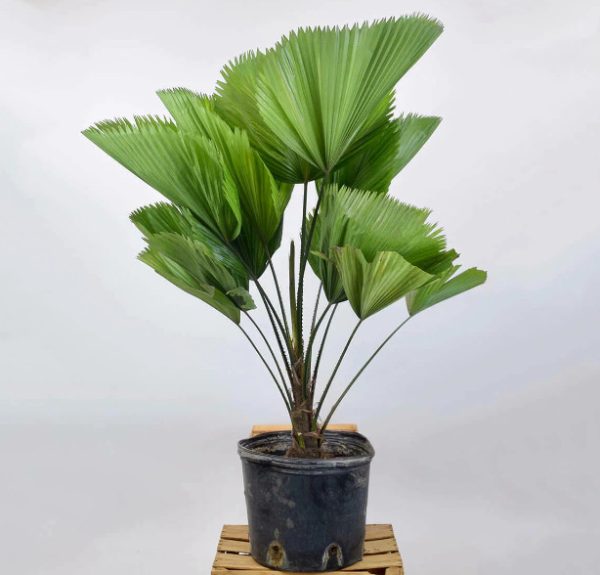
Licuala grandis, often known as the Ruffled Fan Palm, enthralls with its unusually pleated leaves that like hand fans. Although it can be difficult to obtain, this type of palm is rather simple to grow indoors.
Choose a spot that receives plenty of indirect sunshine, and let the top inch or two of soil dry up in between waterings. The health of this magnificent plant depends on adequate drainage.
Colorful Ti Plants (Cordyline fruticosa)
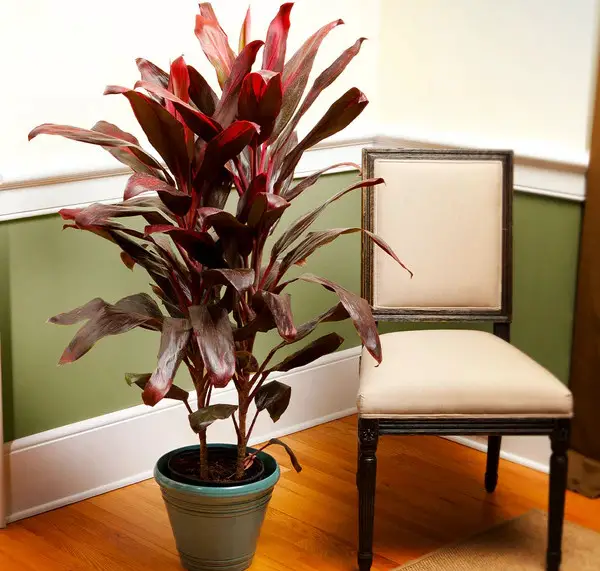
Colorful Ti Plants, scientifically known as Cordyline fruticosa, are perfect for adding vibrant foliage to indoor spaces. With their large red or pink lanceolate leaves and fiery-looking spiky foliage arranged in a rosette shape, they create a striking visual impact.
These plants can grow up to 2 to 4 feet tall indoors and come in various species, including Rubra Cordyline, Firebrand, and Lilinoe. To maintain their stunning multicolored foliage, ensure they receive bright light with a few hours of direct sunlight daily.
Tropical Bromeliad Houseplant (Bromeliaceae)
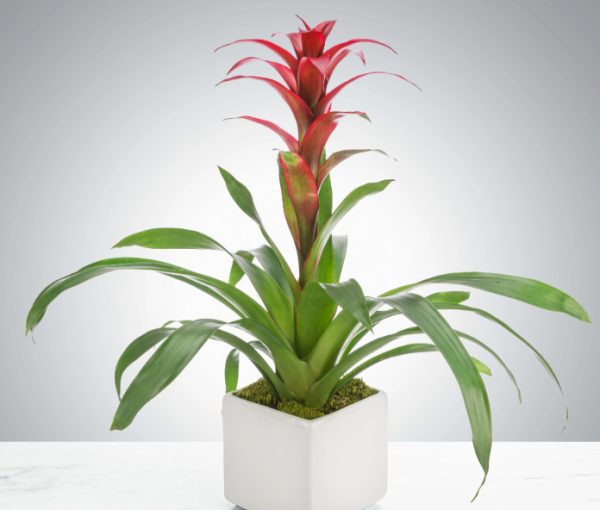
Tropical Bromeliad Houseplants, belonging to the Bromeliaceae family, bring an exotic tropical vibe to indoor environments. With their broad, pointed green leaves arranged in clustered rosettes, they create an eye-catching display. Some species offer leaves in hues of red, maroon, white, gold, or yellow, enhancing their appeal.
These plants thrive in low-light conditions and benefit from high humidity levels, making them ideal choices for adding a touch of the tropics to your indoor space.
Caladium
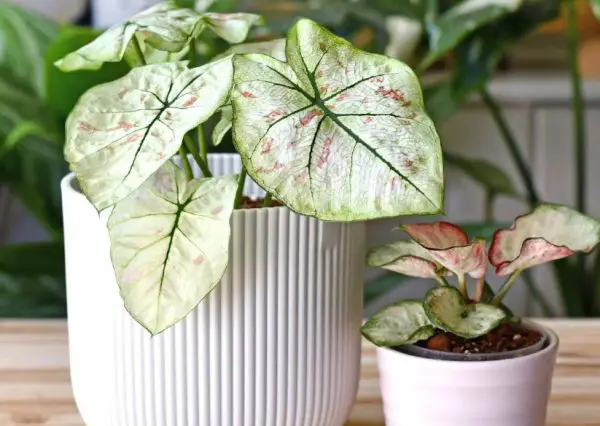
The gorgeous, distinctive foliage of caladium species is highly regarded as it lends a touch of tropical flair to any environment. They have vivid colorful foliage in tones of bright red, deep pink, pure white, or lush green, with heart-shaped or strap-shaped leaves.
Caladium bicolor is the ancestor of many cultivars that have eye-catching patterns. Some create eye-catching visual displays with huge, nearly translucent white leaves with green edges, while others have heart-shaped leaves with vibrant green hues and contrasting lipstick red or pink veins.
Calathea Medallion
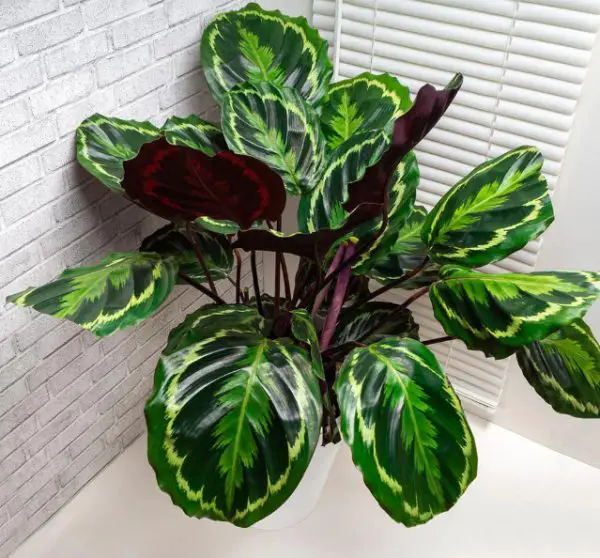
Inside spaces, the Calathea Medallion, another treasure from the Calathea species, adds stunning hues to the foliage. Its round, rounded leaves have complex lime-yellow and green patterns that mimic those of leaves.
This gorgeous tropical plant thrives in bright, indirect sunlight, just like its relatives. The Calathea Medallion brings elegance and brightness to any indoor space with its striking foliage and affinity for indirect light.
Network Plant (Calathea music)
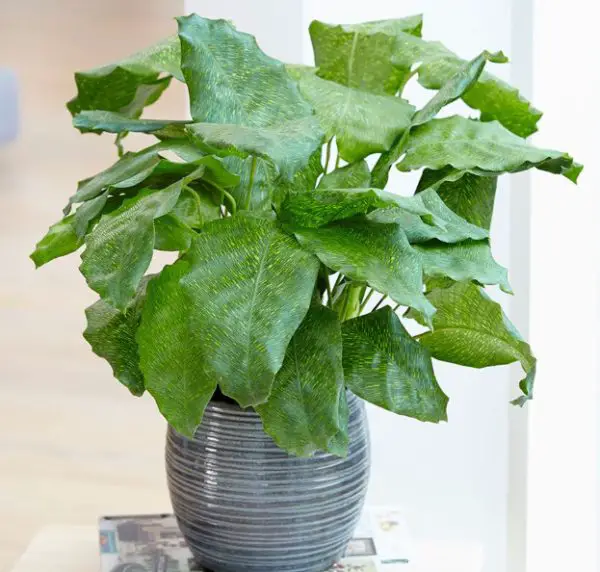
Among the Calathea family, Calathea Music, or the Network Plant, is one of the species with the most remarkable visuals. It has a compelling attractiveness with its enormous light green leaves decorated with intricate patterns like a network, much like binary code.
Its distinctive leaves make it stand out and add something special to any collection of indoor plants.
Lady Palm
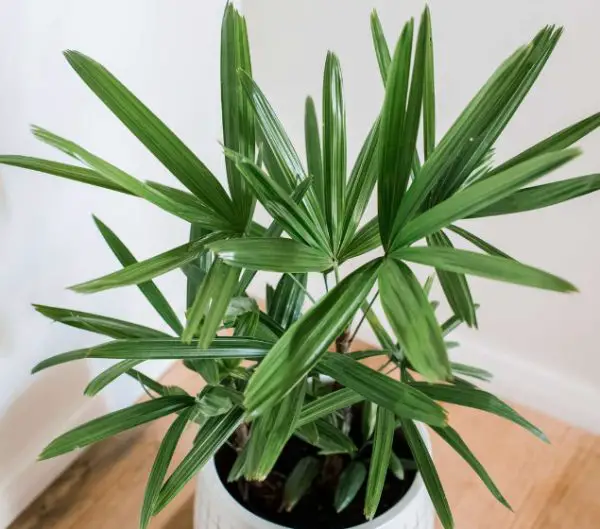
The Lady Palm, also referred to as a parlor plant, is cherished for its large, elegant leaves. Its slow growth makes it ideal for indoor cultivation, where it contributes to air purification.
Thriving in bright, indirect light, it requires watering only when the top two inches of soil are dry. With its graceful appearance and air-purifying qualities, the Lady Palm is a popular choice for enhancing indoor spaces.
Hostas
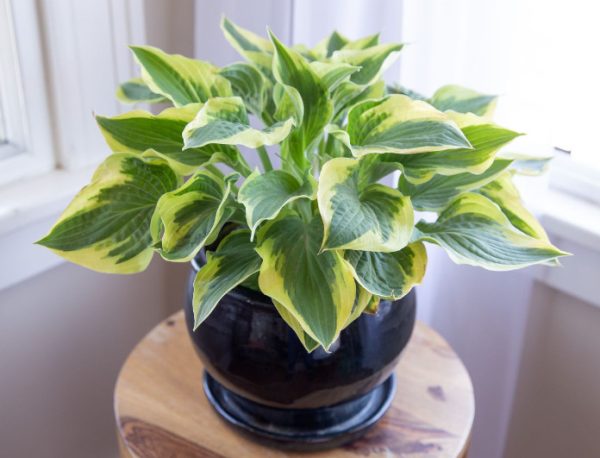
Originating from Northeast Asia, Hostas are shade-tolerant plants prized for their large, colorful leaves. Ranging from vibrant emerald green to silvery blue, their foliage adds a touch of elegance to any shady spot in your home.
To thrive, plant Hostas in rich, slightly acidic organic soil. With their striking appearance and adaptability to shade, Hostas are an excellent choice for enhancing the beauty of indoor spaces.
Cast Iron Plant
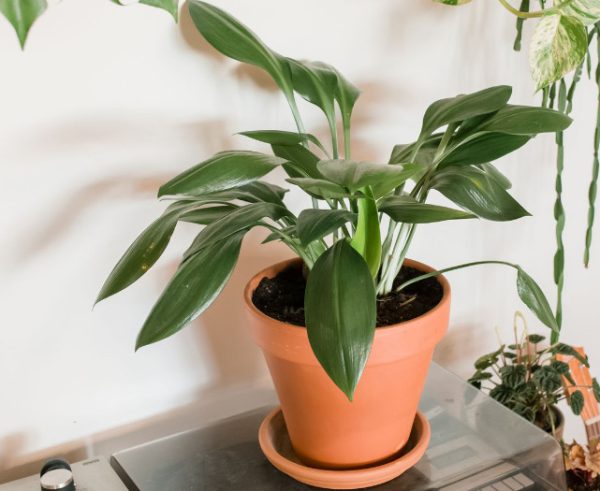
The Cast Iron Plant, with its large green leaves, is an ideal addition to visible areas like living rooms or dining spaces. Reaching heights of about 3 feet, it thrives in low to moderate light conditions without direct sunlight.
Known for its hardiness and low-maintenance nature, the Cast Iron Plant can withstand various environmental conditions, making it a resilient choice for indoor décor.
Corn Plant
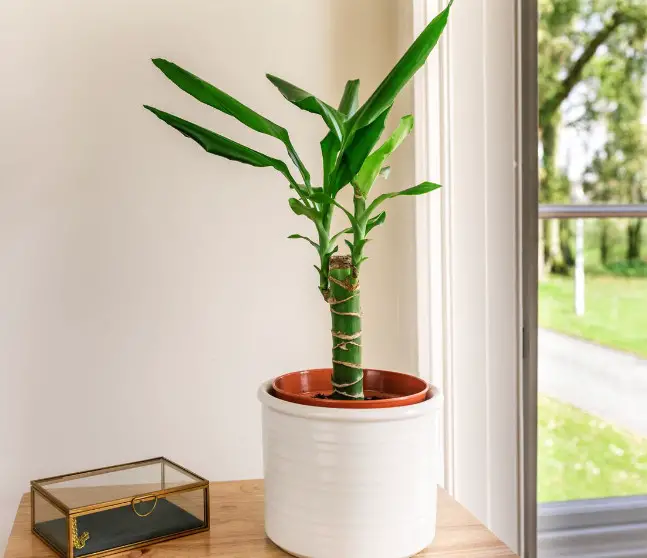
A beloved plant since the middle of the 1800s, the corn plant brings a natural element to any area with its rich green foliage. It thrives in complete shadow and needs little watering, making it ideal for small spaces like apartments.
With plants that may grow to a height of roughly 4 to 6 feet in pots, its tall, narrow growth habit makes it a great choice for small areas.
Elephant Ear Plant
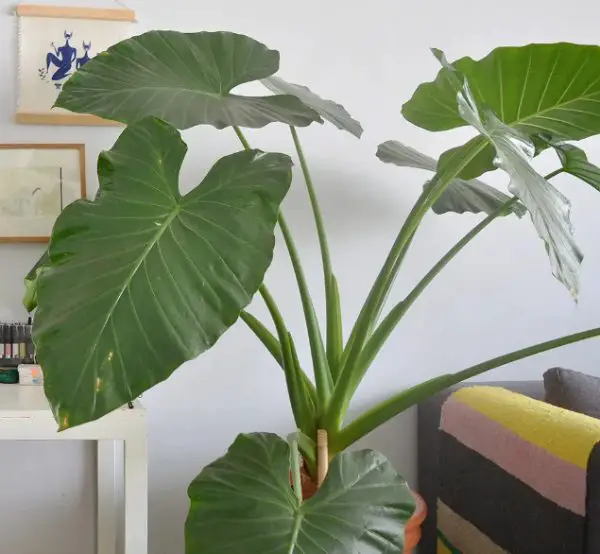
The Elephant Ear Plant, or Colocasia, boasts large green leaves speckled with brown spots, making it a striking addition to any garden. While typically an outdoor plant, it can also enhance indoor spaces with its impressive foliage.
With leaves stretching up to 3 feet in length, their size commands attention. To thrive, it requires bright, indirect light and moist, well-draining soil rich in peat. However, caution is warranted, as it’s toxic to both children and pets.
Bird of Paradise (Strelitzia)
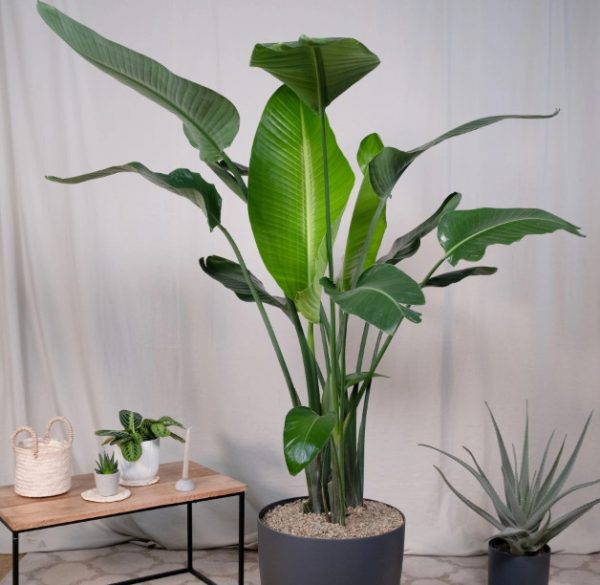
The Bird of Paradise plant, or Strelitzia, is renowned for its lush green foliage and vibrant, bird-like flowers. Its leaves grow in a distinctive self-heading pattern, forming layers around a central stalk. The plant earns its name from its striking blooms, which resemble the plumage of a flying bird.
Indoors, it can reach impressive heights of up to 7 feet tall and 4 feet wide once established. Careful placement is essential, as it’s toxic to children, pets, and horses. Providing bright, indirect light and well-drained, loamy soil ensures optimal growth.
Umbrella Plant (Schefflera arboricola)
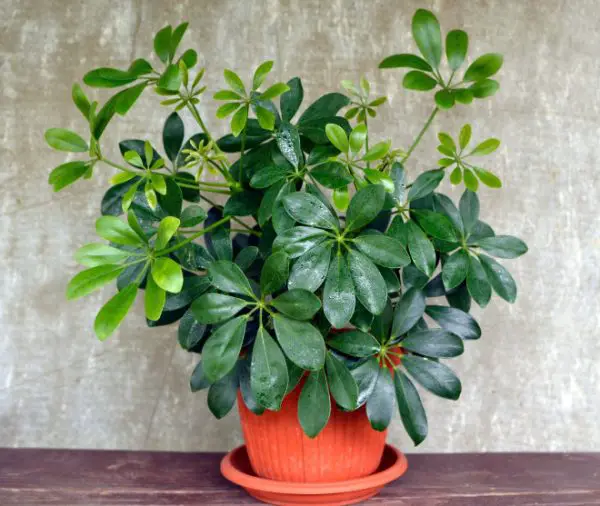
Schefflera arboricola, the scientific name for the umbrella plant, is a stunning plant with raindrop-adorned, rich green foliage. Aptly named for its umbrella-like arrangement of palmate leaves, this indoor tropical classic lends a touch of elegance to any interior setting.
Along its long stems, its unique circular growth pattern, dotted with bright, tiny leaves, produces an eye-catching visual impression. This is an excellent option for people looking to bring some natural beauty and charm into their indoor spaces.
Fiddle Leaf Fig (Ficus lyrata)
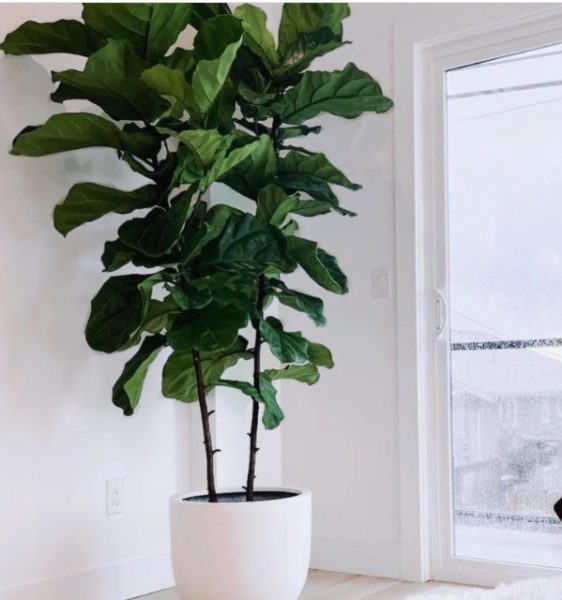
Ficus lyrata, the scientific name for the popular houseplant famed for its enormous, vibrant green leaves, is the scientific name for the Fiddle Leaf Fig. It is a fashionable option for interior décor because of its unusual fiddle-shaped foliage, which lends an air of refinement to any area.
Although highly valued for its visual attractiveness, this plant can be difficult to care for and fussy. It can thrive inside with the right conditions, such as well-draining soil and bright, indirect light, but it’s crucial to remember that it’s poisonous to people and animals alike.
Canna Lily (Canna indica)
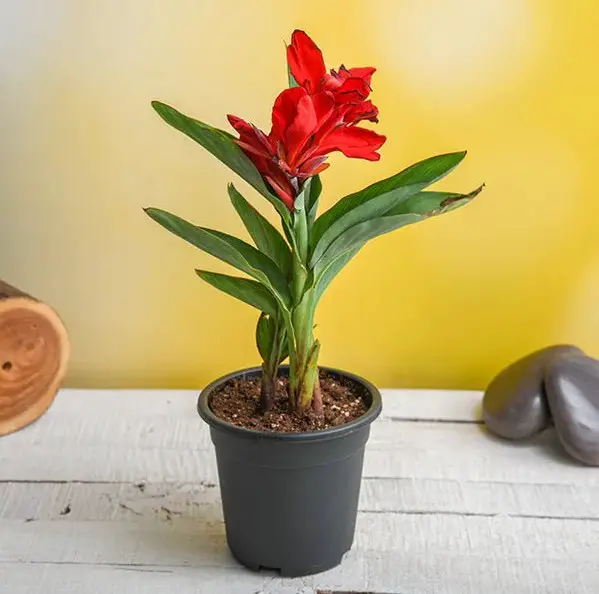
Canna Lilies are the epitome of exotic beauty, with their vivid pink blossoms under the warm sun. These plants add a splash of tropical grandeur to any landscape with their eye-catching green or variegated leaves. Their enormous leaves, which are 8 inches wide and 12 to 24 inches long, provide a rich background for the stunning blossoms.
Climbing to heights of 1.5 to 8 feet on graceful branches, the Canna Lily’s eye-catching clusters of flowers accentuate its beauty against the leaves.
Monstera Deliciosa

Known for its wide, hole-filled leaves, the Monstera Deliciosa is also known as Instagram’s darling. With its spectacular 3- to 4-foot-long foliage, it adds a touch of tropical flair to any area it occupies.
This magnificent plant may grow up to ten feet tall indoors, making a dramatic focal point. It grows well with sporadic watering and thrives in bright, indirect light and well-draining soil, adding lush, emerald splendor to indoor spaces.
Jungle Velvet Calathea (Calathea warscewiczii)
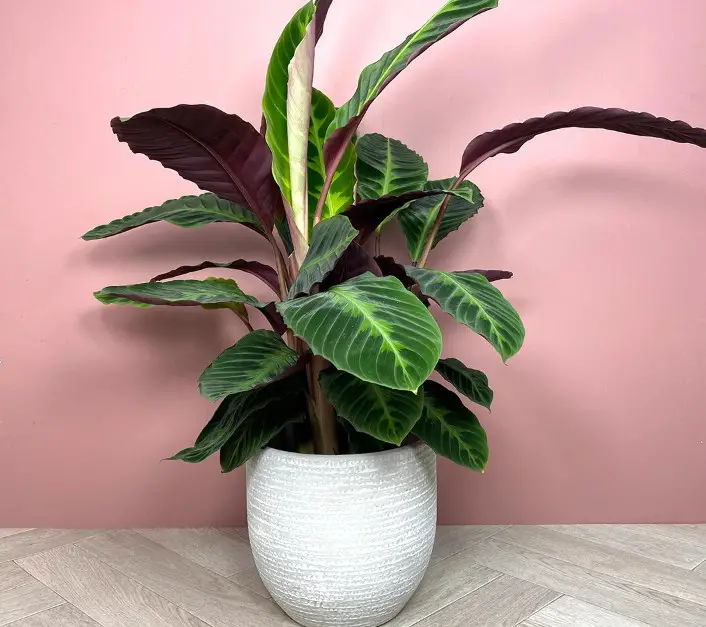
The Jungle Velvet Calathea, also known as Calathea warscewiczii, mesmerizes with its stunning foliage adorned with stripes. Renowned for its large, tropical leaves, this plant effortlessly infuses any space with a lush, tropical ambiance. Its unique characteristics include a velvety purple underside and intricate green fishbone patterns on the upper side of the leaves.
Thriving in bright, indirect sunlight and well-drained, nutrient-rich soil, it’s an ideal choice for those seeking to bring a touch of the jungle indoors.
Philodendron Xanadu
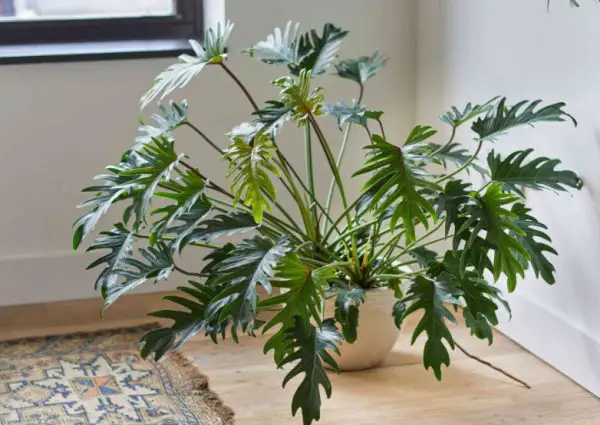
With its eye-catching, huge, leathery leaves, the Philodendron Xanadu is a great focal point for any area. Its leaves get more complex as it ages, with enormous lobes that add to the foliage’s allure.
This plant has to be watered when the soil becomes dry. It grows best in well-drained soil with bright to moderately indirect light. With 10 to 15 lobes, each leaf can reach lengths of up to 40 cm and widths of up to 30 cm. It’s crucial to remember that philodendron xanadu is extremely poisonous and ought to be kept out of children’s and pets’ reach.
Croton Plants (Codiaeum variegatum)
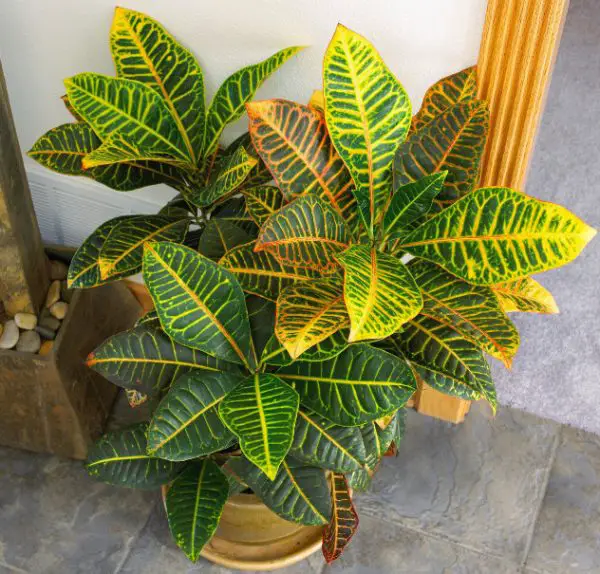
The Croton, or Codiaeum variegatum, as it is named scientifically, is distinguished by its large, vividly colored leaves, which give interior areas an exotic feel. Its leaves display an amazing variety of colors, from bright orange to yellow and green to red and green.
The Croton offers a variety of leaf shapes, such as egg-shaped, oblong, lanceolate, or violin-shaped, and has over 100 variations. Its thick clusters of large leaves, which typically reach a maximum height of three feet, provide a lovely, exotic environment within modern homes.
Rubber Tree (Ficus elastica)
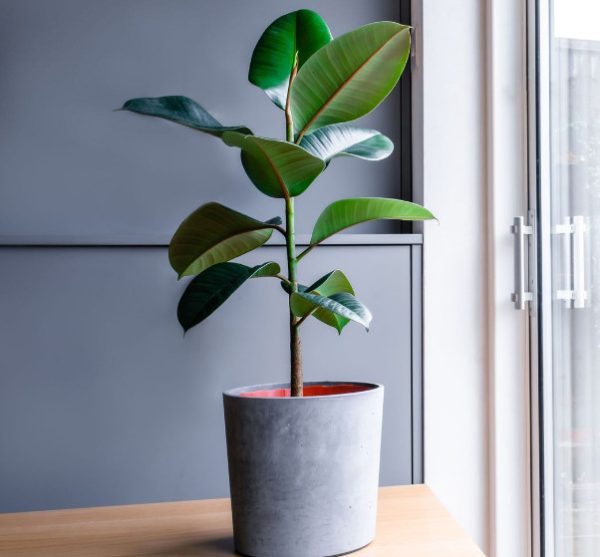
The Rubber Tree, scientifically known as Ficus elastica, is a popular houseplant admired for its diverse colors and leaf shapes. With its large, glossy leaves, it serves as a striking focal point indoors. Thriving in bright, direct sunlight and well-draining soil, this plant requires regular watering during the growing season.
However, it’s essential to note that it’s toxic to cats, dogs, and humans if ingested. Through pruning and root restriction, you can manage its size and shape indoors, although in its natural habitat, it can grow up to 50 feet tall.
Persian Shield (Strobilanthes dyerianus)
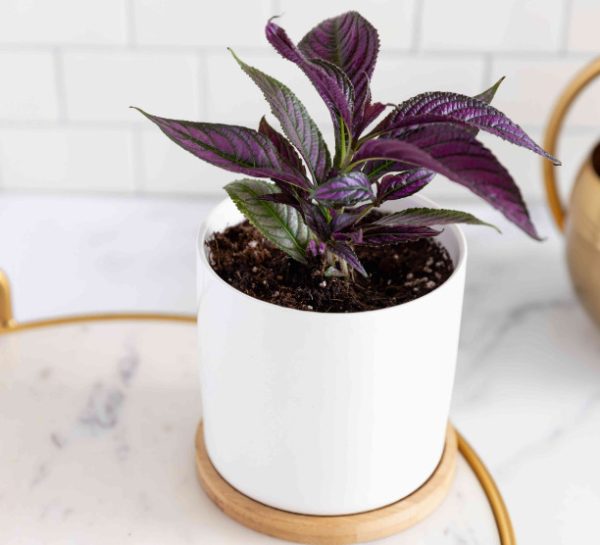
The Persian Shield, scientifically known as Strobilanthes dyerianus, is an exotic houseplant renowned for its large purple leaves that shimmer with an iridescent shine. With lanceolate foliage measuring approximately 7 inches long and 3 inches wide, it exudes tropical elegance.
Indoors, this densely growing plant can develop into a shrubby container specimen, reaching heights and widths of up to 3 feet. Its striking purple foliage earns it the moniker “royal purple plant,” adding a regal touch to any indoor setting.
African Mask Plant (Alocasia amazonica)

The captivating deep green leaves of the African Mask Plant, or Alocasia amazonica, are embellished with delicate white or light green veining. Its foliage, which has a deep purple color on the undersides and resembles arrowheads or hearts, lends an air of elegance to any indoor area.
This gorgeous yet poisonous addition to indoor décor thrives in well-drained, damp soil and should be handled carefully around people and dogs.






